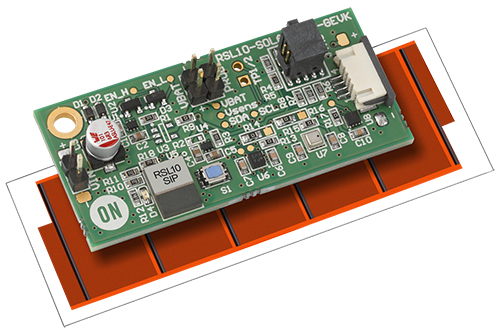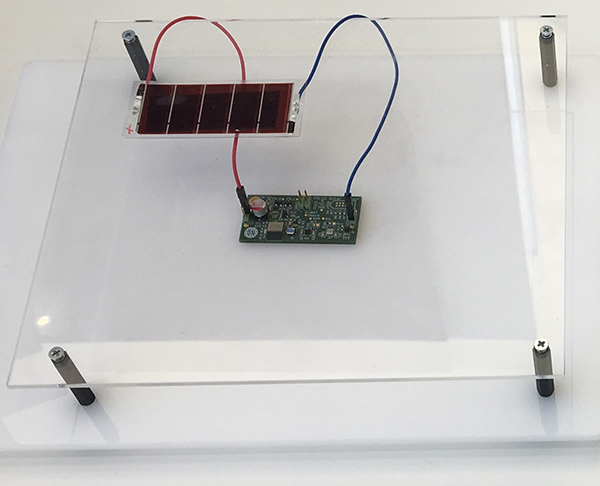Low power tech combines to boost battery-less IoT
The Internet of Things (IoT) needs battery-less and maintenance-free endpoints if it is to achieve its full potential and enable a smarter planet. Bruno Damien, Marketing Director, EMEA IoT, at ON Semiconductor explains further.
With easier access to powerful analytics, demand is growing for sensor data - Cisco’s early prediction of 50 billion connected ‘things’ by 2020 no longer seems quite so ambitious. If even half of such a huge number of devices were powered solely using primary batteries, the cost and environmental burden of providing them – and the management challenges involved with replacing them – could make the IoT unsustainable.
Battery-less smart sensors powered from harvested energy have been on the technological radar for some time. The latest advancements in energy harvesting technology, coupled with new ultra-low-power ICs, sensors and radio technologies such as Bluetooth Low Energy (BLE), mean energy harvesting is now more practicable, effective, affordable, and easier to implement in a compact, reliable form factor.
A lower energy budget
Consider a smart sensor for capturing and transmitting environmental data at regular intervals. The conditions for battery-less operation can be understood by analysing the energy needed to complete each sense-transmit cycle and the repeat interval required. If the system can harvest enough energy to perform at the required duty cycle, long-term battery-less operation is possible.
The energy required depends on the system power and the time to capture and transmit the data. To minimise these demands, BLE and similar protocols such as ZigBee Green Power are optimised to achieve a short frame duration and low transmit power while ensuring adequate security.
Using either of these protocols, it is possible to transmit a complete sensor-data frame in about 10ms (or less). If the sensor node subsystem can perform reliably with, say, 10mA at 1V, a suitable required energy budget can be calculated from: 1Vx10mAx10ms = 100µJ per operation.
This presents some initial targets to consider. Assuming the sensing, processing, and radio subsystems can operate from a voltage close to 1V, the total required energy budget is 100µJ. The energy harvesting subsystem must capture enough energy to make at least 100µJ available to run the circuitry when it is needed. The only limitation is getting this energy to reach a targeted duty cycle. If the duty cycle is between one and ten seconds, the gain factor is quite large for the harvester source to support but not impossible. For example, standard one or two square inch solar cells with conversion energy as low as four percent are able to support this challenge.
To meet these requirements, the system design needs to begin with extremely low-power sensors. Sensors based on the latest MEMS technology can meet these demands, offering ultra-low power consumption through a combination of advanced mechanical design and high feature integration.
Among these, the BME280 environmental sensor from Bosch combines pressure, temperature, and humidity sensors in a low-power all-in-one device. In addition, the BMA400 is the industry’s first 3-axis accelerometer to deliver true ultra-low-power operation without sacrificing performance. By combining these devices, it is possible to create an extremely low power multi-sensor platform with added inertial sensing for applications such as climate control, process monitoring, asset tracking or intrusion detection.
SIP integration
To tackle challenges in the processing and radio subsystems, ON Semiconductor has brought a combination of ultra-low-power technologies together in the RSL10 System-in-Package (RSL10 SIP). The RSL10 SIP contains a radio SoC, integrated antenna, integrated power management, and all passive components required.
Power consumption is extremely low, at 62.5nW in Deep Sleep Mode and 7mW in receive mode. The SiP operates from a supply voltage down to 1.1V and features integrated Flash and RAM. At the same time, it incorporates support for Firmware Over the Air (FOTA) upgrade with memory protection and is certified to worldwide regulatory standards including CE and US FCC approvals.
Now, combining the RSL10 SiP with the ultra-low-power BME280 and BMA400 sensors, as well as ON Semiconductor’s NCT203 digital thermometer and alarm, has resulted in the RSL10 Solar Cell Multi-Sensor Platform (Figure 1).

Above: Figure 1. The RSL10 Solar Cell Multi-Sensor Platform with attached solar panel and ready to transmit sensor data over Bluetooth Low Energy (BLE)
This ready to use battery-less sensor node connects to a hub such as a gateway or smartphone using BLE, and is supplied with source code, schematics and Gerber files to allow customisation.
Energy harvesting
The combination of ultra-low-power technologies featured in the RSL10 Multi-Sensor Platform can capture and transmit environmental and inertial data within a timeframe of below 10ms, consuming an average current of around 10mA. To make this a practical application, the energy-harvesting subsystem need only provide enough energy to support this activity when operating at a suitable duty cycle.
As the rate at which energy can be harvested from ambient sources, such as solar, is typically low, one approach is to implement what is known as a gain factor in relation to the system energy demand. For example, accumulating energy a period of, say, one second, and operating the sensor for ten milliseconds creates a gain factor of 100. Harvesting for ten seconds and sensing/transmitting for 5ms creates a gain of 2,000.
To power the RSL10 Solar Cell Multi-Sensor Platform for a 10ms protocol transmission once per second, the harvesting gain factor is about 100. With continuous harvesting for ten seconds between transmissions, the gain will be 1,000. Based on these figures, the solar harvester needs to provide a current source of 10mA/100 = 100µA or 10mA/1,000 = 10µA to transmit at one-second or ten second intervals respectively. This information helps choose a suitable solar module to power the RSL10 Solar Cell Multi-Sensor platform. This can then be connected using the two-port connector provided on-board.
The Ribes Tech FlexRB-25-7030 solar module meets the requirement almost exactly by providing 16µA at 200lux or 80µA at 1,000 Lux, which is enough to perform a 10ms data transmission at a maximum rate of about once per second (Figure 2). 200lux is a typical indoor natural-light intensity in northern Europe during cloudy, winter afternoon daylight. Brighter sunlight, additional artificial light sources, or positioning outdoors or near a window can increase illumination by several hundred lux.

Above: Figure 2. The RSL10 Solar Cell Multi-Sensor Platform has been demonstrated with a commercial solar panel capable of supplying 16µA at 200lux
Harvested ambient energy is typically stored in a capacitor or rechargeable battery, depending on application requirements. Capacitors, with their lower energy density, store less energy than batteries for a given volume. Hence, a secondary cell may be preferred in a solar powered application that must remain active for long periods when no ambient light is expected.
Any energy storage selection should also consider arrangements for controlling both charging and discharging. A battery requires protection against over-charging and over-discharging, which may call for a switching regulator and that introduces an additional IC and external components. On the other hand, a capacitor of suitable voltage rating requires no charging circuit or protection components. In each case, however, output-voltage regulation is needed.
The RSL10 sensor platform has a low-profile 47µF storage capacitor and the voltage is regulated using ON Semiconductor’s NCP170, a simple low-dropout linear regulator (LDO) with ultra-low quiescent current that helps minimise leakage of precious harvested energy. Moreover, the devices on-board are selected to have either a low minimum input voltage or wide supply voltage range to support the simple regulation strategy.
The storage capacitor allows deployment in locations where ambient lighting is strong and long periods of darkness are not expected. In such contexts, continuous operation is possible. The module comes pre-flashed with interweaving beacon firmware to broadcast sensor data and system-status data such as capacitor voltage level, leveraging Bluetooth 5’s beacon mode. The firmware is compatible with iOS or Android BLE Scanner applications.
Conclusion
The gap between typical embedded system power demands and the energy provided by harvesting systems is being bridged. Harvesting technologies are now more effective at capturing ambient energy, but it is thanks to the relentless development of ultra-low-power semiconductor technologies and efficient radio-transmission protocols, such as BLE, that truly battery-less IoT endpoints are now viable. The turnkey RSL10 Solar Cell Multi-Sensor platform shows that battery-less sensors are now ready for widespread IoT deployments.











